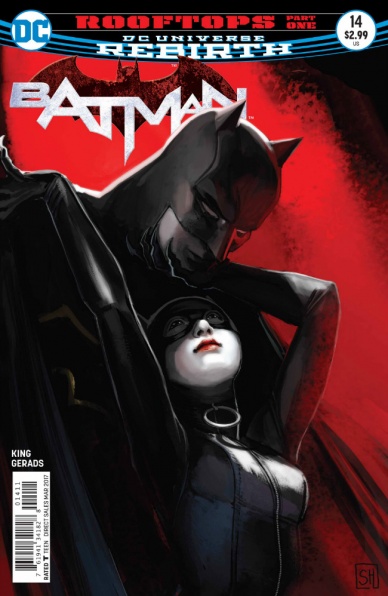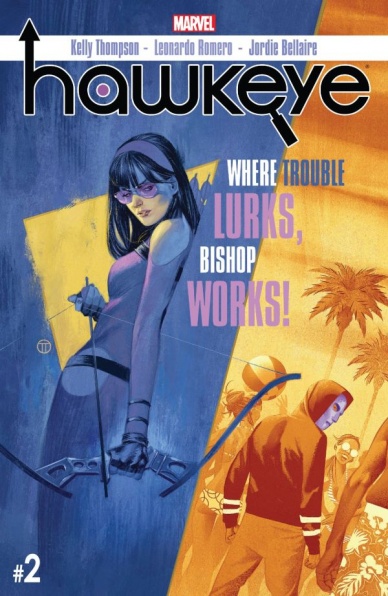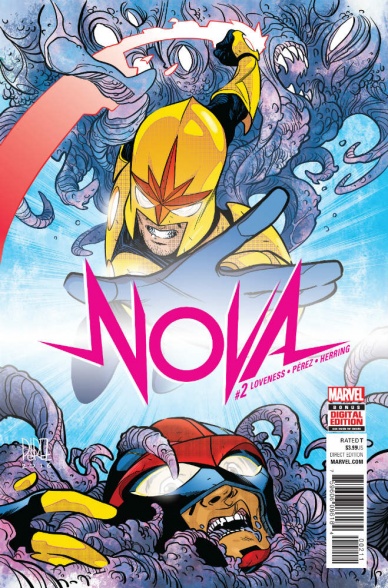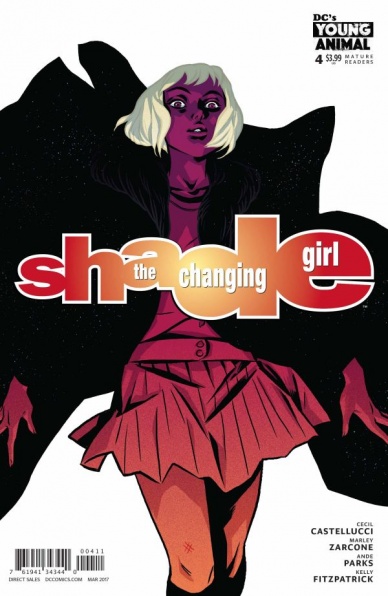There is a lot to cover on Wednesdays. We should know, as collectively, we read an insane amount of comics. Even with a large review staff, it’s hard to get to everything. With that in mind, we’re back with Wrapping Wednesday, where we look at some of the books we missed in what was another great week of comics.
Let’s get this party started.

Batman #14
Written by Tom King
Illustrated by Mitch Gerads
Reviewed by Alice W. Castle
After 14 issues, I still don’t think Tom King has taken to “Batman” quite as well as people had hoped. Between the two story arcs presented thus far (‘Night Of The Monster Men’ notwithstanding because it was a crossover), Tom King’s take on Batman seems to feel less like a person and more like collection of attempted iconic moments and lines. This issue seems to want to fix that.
And misses the mark pretty far.
The entire issue is presented as the first part of Bruce and Selina’s final farewell before she is sentenced to a prison for having killed 237 people…at some point. On a small scale, this issue doesn’t work because it is plagued with stilted, unnatural dialogue that doesn’t feel like two people talking, but feels like a writer trying to force a new iconic moment between two iconic characters. Its flow stutters through sentence fragments and frequent repetition of key phrases that are neither as profound as presented or interesting enough to carry the entire issue. It feels clinical, like an attempt to recreate Scott Snyder’s emulation of Frank Miller. Batman refracted through enough lenses that he’s no longer a person and is little more than a walking marketing brand.
On a larger scale, the issue doesn’t work because the story is presented on a narrative fallacy. Catwoman tracked down and murdered 237 men in cold blood because they’re terrorists and every Tom King story has to have terrorists dying. This happened at some point in the past and is something we were only privy to, as the reader, through her narration. It’s something that was supposed to be shocking, but mostly comes off as nonsensical because we have no connection to this part of Selina’s backstory or why it would be so important for her to commit mass murder over it. Even Batman doesn’t believe it, but there’s a dissonance between having Batman disbelieve something that has hard evidence because he knows it to be out of character for the person and presenting the flimsiest reason for why a character would behave that way and expect the reader to buy into it. If Tom King is expecting to turn around next issue and say “Oh, she didn’t really kill all those people!” it would maybe be the thinnest bait and switch in comics history.
Thankfully, this issue is at least pretty. Mitch Gerads does stellar work with a script that’s pretty static. Almost the first ten pages are nothing but dialogue between Batman and Catwoman, so Gerads keeps most of the issue in thin, wide panels that crop close to the characters face. These wide panels keep the focus on the eye line between the two characters and brings an intimacy not found in the dialogue.
Gerads colours the issue also, bringing cool blue tones to the nighttime of Gotham that is only briefly punctuated by muted reds like Catwoman’s goggles. It’s a fairly monochrome issue, highlighting the somber mood of the two characters and using the muted reds to punctuate the waning passion between the two.
Tom King’s run on “Batman” seems to be an exercise in ideas that fall apart. If this issue is any indication, a large part of that is his reliance on characters speaking in trite metaphors instead of feeling like actual people under those masks.
Final Verdict: 4.0 – A far cry from the heights people hoped Tom King would take the Caped Crusader.

Hawkeye #2
Written by Kelly Thompson
Illustrated by Leonardo Romero
Reviewed by Paul Lai
Disappearing under Clint Barton’s shadow has never been a problem for Kate Bishop, especially since Fraction, Aja, and Wu’s watershed run found her verve and vivacity to be a perfect tonal complement to Clint’s scruff. The last “All-New” Lemire and Perez series confirmed unmistakably that Kate would take the mantle, and Now, she IS Hawkeye, no qualifiers. And just like her quiver’s stocked with Clint’s tricks and wit while remaining utterly original, her creators are tasked with finding a set of problems and a cast of relationships that suit the Kate Bishop Hawkeye distinctively.
Continued belowCredit editor Sana Amanat for bringing Thompson and Romero together to make the character sing, along with the always-excellent Jordie Bellaire on colors (no credit for that no-brainer). The first issue laid down a visual and story rhythm that sampled from those Fraction/Aja/Wu beats, but created its own distinct fusion. Romero’s style lands somewhere between Francavilla and Shaner, so it emanates a David Aja vibe without descending into imitation, adding a touch of that ’40s noirish Joan Crawford to that ’70s Steve McQueen-ness.
I for one enjoy the combination of that subdued, taut PI aesthetic with Kelly Thompson’s quippy and chatty freshness. Thompson has a talent for proving that a youthful sensibility can often contain a truthful sensitivity, so Kate’s current story finds her confronting a social network villainy that us out-of-touch old people might judge as slight and faddish. But our politics and news headlines should remind us that what Kate’s tangling with troubles us as much as any contemporary social ill: the hordes of trolling online harassers that wield a dark and suppressive power in our times.
With a target that is so germane but also so abstract, Thompson and Romero could easily slip off the tightrope between a story that is too impersonal on one side or too small-scale on the other. But thus far, I think they’re hitting the mark, embedding those thematic problems in a growing and likable (if somewhat predictable) supporting cast like neighbor Ramone and lab-nerd Quinn. And they’ve seasoned with proceedings with lightness in the banter and that Hawkeye-trademarked design-y fun, like those motion-cap panels with Hawkeye flipping-and-kicking her way through a series of foes in a single wideframe. Judging by these first two issues, I’m on board to see if they stick the landing.
Final Verdict: 7.4 – Thompson and Romero refine Kate’s aim, and it’s on target

Nova #2
Written by Jeff Loveness & Ramon Perez
Illustrated by Ramon Perez
Review by Ken Godberson III
When I reviewed the first issue, I said I really enjoyed it, in spite of not liking the idea of Rich Rider being back. Now that I have read issue #2, I am liking it even more, and it’s because Loveness and Perez are fully diving into something really important: Rich is old. The world didn’t stop because he was dead. And this issue dives further into that as Rich and Sam encounter one another and have their first interactions. It can’t be underestimated how much respect Lovness and Perez give both Rich and Sam. They’re are not trying to shill one or the other as “the greatest Nova ever,” but are trying to establish them as two flawed individuals while also delivering some great wit and fun with it. There is one reunitement between Rich and a beloved “Guardians of the Galaxy” character that’ll guarantee a smile.
Perez and Ian Herring’s artwork continues to shine. After the Nova books having more samey artists over its last two volumes, this more cartoonish and sharper style makes the series feel more unique. The art allows for great effective range, from Sam and Rich fighting cosmic tentacle-y horror to the more low-key brightness of Sam and Rich at a barbeque. Major nods have to go to Herring’s colors, when even there is a somber moment, his work never feels dull. One example is when Sam shows Rich the Nova helmets he’s found (a nice nod back to the Duggan/Medina work), the coloring is kept dim and contemplative, but never feeling drab.
Only downside is that the ending of the issue feels a bit forced, but when you have two issues full of greatness, I’m willing to forgive it a bit.
Final Verdict: 8.6- This book is showing a lot of promise by showing respect to both characters and remaining heartfelt.

One Punch Man Volume 10
Written by ONE
Illustrated by Yusuke Murata
Reviewed by Robbie Pleasant
Is there a single issue of “One Punch Man” that isn’t fantastic? So far, the answer is a resounding “no,” and this volume continues to be excellent in all regards – characters, story, art, comedy, and world-building are all touched upon and are all great. In fact, Saitama himself is scarcely the focus of any chapter, as the story looks more at the supporting characters, antagonists, and even the Hero Association itself.
Continued belowOf course, as Saitama can one-shot any threat, keeping him sidelined or distracted is necessary in order to build up the threats and let the other characters have a chance to shine. It does indeed do a good job building up Garo, the “hero hunter” who’s targeting heroes of every rank and size, while getting Saitama set on a path that may or may not result in a showdown with him. Either way, it’ll be a blast.
More importantly, though, are all the secondary characters it builds up, and those it introduces. We get to learn more about the people behind the Hero Association, and the manga pulls no punches on showing that they’re pretty lousy people. Every line they speak, every action they take, and even the way they’re drawn show that the Hero Association’s higher ups – the ones that don’t get involved in any actual heroics – are just like anyone else corrupted by wealth and power. It’s the heroes themselves that we grow to love, from seeing characters like Metal Bat or Spring Mustachio in action to brief introductions of minor heroes (I’m particularly fond of the Class C, rank 111 hero: Armored Assistant Manager), that really give us characters to root for and relate with, and they make the world within the series stronger and wider.
But while ONE’s story and characters make it a joy to read, the art by Yusuke Murata makes it a joy to behold. The series has a way of switching between super-detailed and minimalistic in a single beat, but every time it sets and matches the tone perfectly. There are some great characters in concept, but the artwork really brings them to life. In this single volume we get a big-lipped, pot-bellied Hero Assiciation head honcho in a polka dot bow tie (and his matching son), a short-legged martial artist with a chin that takes up half his face, a hero whose theme is his red nose, and another hero who dresses like a giant armored pineapple – and those are just the new human characters!
The monsters the heroes fight are equally fantastic, covered in detail that always adds to the awe of the scene. There are centipede monsters of all sizes (centisenpai is worthy of note), monstrous plants, a monster that seems to be a combination of Gamera and Gidorah, and even a hot dog monster. Everything looks unique and fantastic.
So when we put those heroes and monsters together, of course the action looks great as well. The series has always been one to toy with typical manga tropes, with boastful speeches, ever-escalating threats, and powers that defy all logic, but it always makes it work so well. Sure, it’s fun to see Saitama destroy anything he fights with one punch, but oh does it ever look so good as it leads up to it.
Final Verdict: 9.3 – As with every volume so far, an absolutely stunning combination of story, character, and artwork.

Shade, The Changing Girl #4
Written by Cecil Castellucci
Illustrated by Marley Zarcone and Kelly Fitzpatrick
Reviewed by Jess Camacho
Of all the Young Animal titles, none have felt as young as “Shade, The Changing Girl”. This series has been the kind of thing that DC has needed and its fourth issue continues the hot streak the series is on. By this point, Castellucci is really diving deeper into the strange place that Loma has found herself in. This world is so different and she’s learning that yes, her life is far more complicated that she ever imagined but she can make something good of it and possibly put right what Megan messed up. This issue begins to flesh out her new friendship with River and really starts to form what the series will be going forward.
Zarcone continues to blow me away with her dizzying and gorgeous layouts. This isn’t an easy series to step into given all the great work that was done on previous series, but she’s been stellar from the get go. “Shade” #4 brings Loma down to Earth a bit more as she navigates her new life in a more meaningful sense but throughout, that madness is never completely gone. Fitzpatrick’s colorful backgrounds and use of bright neons keeps that in the forefront without taking us out of the setting. Zarcone nails the emotive nature of teen drama and each panel with Megan’s bewildered parents is a gem.
Continued belowThe issue also features a back story by Magdalene Visaggio and Paulina Ganucheau that stars Element Girl. In just a couple of pages, this team tells a heart breaking and tragic “what if” story that will resonate with you even if you’re unfamiliar with the character. It’s startling how much was done with so little space and I’m glad that this series features back ups like this.
Final Verdict: 8.0 – This continues to be my favorite of the Young Animal books.

Superman #14
Written by Peter Tomasi and Patrick Gleason
Illustrated by Ivan Reis
Reviewed by Brian Salvatore
Look, let’s get real: any story that involves two Supermen whistling the cosmic song from “Final Crisis” is going to get my juices flowing. Throw in a ton of multiversal characters, and I’m yours. This issue is, perhaps, the strongest commentary yet on the breadth of ‘Rebirth’ – there’s nothing off limits, there’s nothing too weird, there’s no creator’s run which cannot be mined. And that is a glorious, glorious thing.
“Superman,” the title, has been one of the most refreshing in all of ‘Rebirth’ because it seems to recognize the wide open possibilities, and is doing everything within its power. From the small, county fair story of #7 to this, literally a story too big for one universe, it has been a constant examination of all the types of Superman stories there are. Because of this, it doesn’t feel out of place that, two weeks after hanging out with Frankenstein and his Bride, we get inter-dimensional travel with lots of analogues of all shapes and sizes.
Ivan Reis, due to start his “Justice League of America” assignment in just a few weeks, was the logical choice here, reprising his duties from “The Multiversity” to handle the issue. His bombast and precision truly takes the story into that iconic, world defining range almost instantly. While I don’t think Reis is a perfect fit on many of the stories he’s assigned, here he fits like a glove.
Tomasi and Gleason even throw a shocking ending in there, one that has both no stakes whatsoever and a huge amount at stake for the diehards out there who have been reading DC for decades. This is how you do a story like this.
Final Verdict: 8.8 – A truly bombastic, enthralling trip through the Multiverse.

The Young Protectors Vol. 1: Engaging the Enemy
Written by Alex Woolfson
Illustrated by Adam Dekraker and Veronica Gandini
Reviewed by Matthew Garcia
Big, loud, over-the-top, bright, ridiculous, sexy, and fun, “The Young Protectors Vol. 1: Engaging the Enemy” is a quintessential superhero comic. It’s also a daddykink comic of the most steamy order. The story follows Kyle, who’s part of this Teen Titans-esque group of superkids, where he’s known as Red Hot. He’s also deeply in the closet while desperately wanting to have his first gay experience. So one night he sneaks to a gay bar where he’s caught by The Annihilator, a gay super villain who also happens to be crushing on Red Hot. Cue a sort of empowered meet cute and before you know it, they’re making out in a back alley and Kyle’s finding himself torn between his superhero team, his desire to be with The Annihilator, and his own questions about himself.
I had been following “The Young Protectors” for a while when it was being published online, but now writer Alex Woolfson has collected the first couple chapters into one volume (debuting this week on comiXology). The book most definitely reads better in this format. Adam Dekraker stages his pages like a superhero comic, so the panels are often vertical or big or jumping all over the place. It’s far easier to read without having to scroll back and forth.
Dekraker’s artwork is Marvel-ready, clean but representational. Woolfson’s conversation pages and exposition dumps can go on for pages and pages, but Dekraker makes the most of it. The boys are all gorgeous here and it’s obvious he’s having a grand ole time drawing their muscles and chiseled chins and pristine figures and bubble butts panel after panel. His work tends to reveal as possible without going totally NSFW, and sometimes that’s funny but other times it’s annoying. (Either commit or go home, this comic was literally posted on a site called YAOI911.) While the visuals might not be anything different than your typical Marvel or DC book, they are genuinely exciting in the story’s context and as loud and spectacular as you want from a superhero comic.
“The Young Protectors Vol. 1: Engaging the Enemy” knows what kind of comic it is and what it wants to be and doesn’t overshoot its ambition. Woolfson has a strong grip these characters and their voices; you do get invested in their post-teen/pre-adult conflicts, dilemmas, and insecurities. He balances the plot and the character development well, even though his dialogue pages go forever without any real progress in the scene. It’s a fun book, if fleeting; more of a fling than a long-term commitment. I was excited to see it pop up on comiXology, but even within the time I wrote this review, it’s faded into a blur of sexy bodies and angst.
Final Verdict: 7.0 – Bright and full of spectacle, a fun little piece of entertainment.






